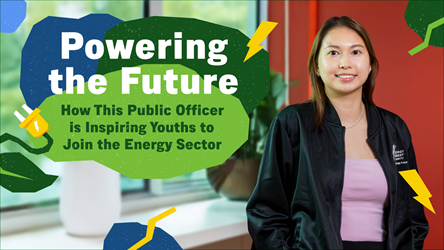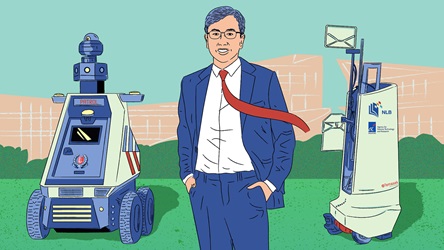The Engineer Who Studied Psychology

Mr Hor Guoyong may not don a uniform or wear a badge as a Home Team officer, but he plays a crucial role in helping to keep Singapore's borders safe.
At Woodlands Checkpoint, where hundreds of thousands of travellers pass through the immigration halls daily, Home Team officers keep a lookout for suspicious travellers and activities. Imagine this scenario: amidst the crowd, a person-of-interest is scanning the hall and behaving suspiciously. Spotting several surveillance cameras, he ducks his head to hide his face. But very quickly, two Home Team officers stop him for checks. How did they spot him so quickly, given the throng of travellers?
The officers are helped by a customised video analytics system that performs facial recognition real time, matching faces in video footage against a large database. Since the system was implemented in 2012, it has helped the Home Team sieve out persons-of-interest.
Enhancing the security senses of officers is Mr Hor's work at the Ministry of Home Affairs Office of the Chief Science and Technology Officer (OCSTO) department. As a Human Factors Engineer, he focuses on improving and adapting technology, as well as equipment and officers' work environment, to complement their capabilities, cognition and behaviour.
Mr Hor's background is not in engineering but in psychology, where he specialised in studying the mental processes that affect interactions between man and machine. "Human factors engineering is about understanding human limits and potential, and designing systems that are compatible with people's physical and cognitive abilities," he explains.
For instance, the video analytics system, known as the Automated Biometric and Behavioural Screening Suite (ABBSS), compensates for "vigilance decrement" - a natural decline in the human ability to sense suspicious people or events over time due to psychological stress or mental overload.
The ABBSS automates time-consuming but necessary tasks such as sieving out persons-of-interest or unattended baggage and capturing the number plates of fast-moving vehicles. The system also scans video footage for events-of-interest based on factors such as colour, size, speed and direction of movement. This helps Immigration & Checkpoints Authority (ICA) officers to detect undesirable persons trying to enter Singapore.
Besides having a firm grasp of the latest trends and developments in technology, Mr Hor's work also requires that he understands the mental and physical needs and capacities of Home Team officers.
He and his colleagues interview the officers and observe them at work to understand their challenges and needs. He then liaises with system integrators and vendors to customise existing technology, systems and devices to suit the Home Team's operational needs.
It was only after joining the OCSTO that the psychology graduate picked up skills in engineering and video analytics. Despite the "extremely steep" learning curve, he says with pride: "I get to work on game-changing projects that enhance homeland security." The ABBSS will be implemented at other checkpoints in the next few years, he adds.
As with most engineers, Mr Hor does site visits too. But rather than look out for technical or construction faults, he puts himself in the shoes of officers, to see how they handle peak-hour crowds, for example.
Mr Hor can also draw from his previous role as an ICA officer, during which he spent two and half years at Woodlands Checkpoint. "This personal experience on the ground allows me to better understand the needs and concerns of Home Team officers more deeply."
Ultimately, what excites him most is the fusion of psychology and technology in his job, "working with two ends of the spectrum… and bringing these two together to work hand in hand".
Calling all engineers! The Public Service Engineering Conference is happening again on July 24, 2018. Find out how your fellow engineers push boundaries to provide integrated and innovative solutions. More details to be posted on Workplace [WOG] Engineers@Gov in time to come.
- POSTED ON
Feb 26, 2018
- TEXT BY
Tuber
- PHOTOS BY
Roy Lim









